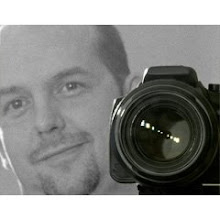Yesterday was "Worldwide Pinhole Photography Day" (see www.pinholeday.org ), and the Center for Fine Art Photography held a workshop where we built cameras out of a cardboard boxes, and developed the images. The last time I stepped foot in a darkroom was in high school nearly twenty years ago, but after attending the workshop yesterday, I want to run to the camera store and buy some black and white photo paper, developer, and fixer, and start building my darkroom, and a plethora of homemade cameras. I have an empty room in my home that I don't use, and it seems to be the perfect place for a small darkroom. I'm sure I will put together an overly-verbiose post about the construction of this new project as I start and complete it, but for now, I thought I would share my Pinhole Photography experiences.
Who knew you could make a camera out of a cardboard box and some electrical tape? The beauty and strength of pinhole photography is in the ability to achieve practically unlimited depth of field. Not to get too technical, but for you math whizzes, here's the formula for determining aperture on a pinhole camera:
f/stop = focal length
pinhole diameter
Okay, I'm not a math whiz either, so I won't elaborate. There is a very good article explaining this concept in-depth at http://ca.geocities.com/penate@rogers.com/pinsize.htm. In short, with my little cardboard box, I was able to achieve an aperture of somewhere between f200-something and f500-something. This extreme depth of field means that I could place the camera a few inches away from an object, and have that object in good focus, and still have a mountainous horizon in the background in good focus as well.
 I'm not sure why I chose the truck, other than it really looked more beat up, and had much more character than these photos indicate. I was also singularly focused on the technical aspects of my cardboard box, and the actual photo at this point was secondary.
I'm not sure why I chose the truck, other than it really looked more beat up, and had much more character than these photos indicate. I was also singularly focused on the technical aspects of my cardboard box, and the actual photo at this point was secondary.This first shot was taken in very bright sun, with a 7-second exposure. The sun was reflecting brightly off of the hubcap, thus the extreme contrast.
 This second shot was a 30-second exposure taken in the shade. Notice that the building in the far distance is in as sharp of focus as the truck? This photo may not be the best example of that, because the wind caused a bit of camera movement.
This second shot was a 30-second exposure taken in the shade. Notice that the building in the far distance is in as sharp of focus as the truck? This photo may not be the best example of that, because the wind caused a bit of camera movement.Impressive photos? Most definitely not. Enough of a start to motivate me to keep trying it? Yes. Unexpectedly, I really got a lot of satisfaction out of the rudimentary nature of this style of photography.
I have some big plans for some old dead trees near my house in the near future...
For anyone interested in learning more about pinhole photography,
The Center for Fine Art Photography is holding an Intermediate Pinhole Workshop on May 20th in Fort Collins, Colorado. The instructor, Micheal Butts, is an expert on the subject, devoting his last 18 years to Pinhole Photography. He is an excellent instructor.
(You can read a new post about Pinhole Photography from 05/14/07 here)



